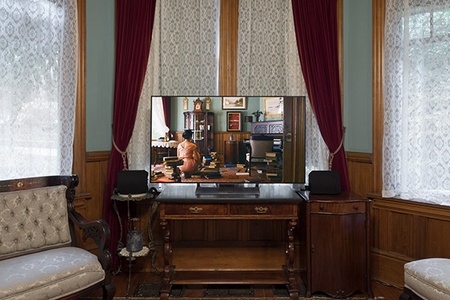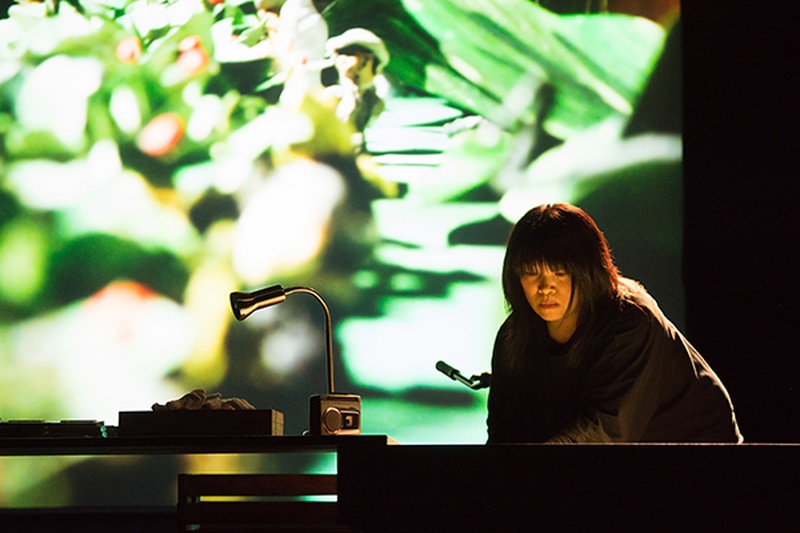VANCOUVER — Interdisciplinary artist Cindy Mochizuki explores a variety of mediums to create art that engages audiences with Japanese Canadian narratives and histories. Whether through painting, sculpture, drawing, dance, film, audio fiction, or even divination, at the heart of each project is thoughtful and thought-provoking storytelling, often about stories and moments overlooked in history.
This October, the Vancouver-based artist was recognized with the Jack and Doris Shadbolt Foundation’s VIVA Award, a prestigious cultural award in B.C. The annual award does not accept applications or nominations. Instead, a selection committee from the art community selects three artists whose body of work has contributed to B.C.’s culture and community.
“To have my practice recognized in this way was a big honour, and maybe a surprise or a bit of a shock,” Mochizuki tells Nikkei Voice in an interview. “It’s allowed me to go back down a long, deep trajectory of my art practice, why I make work, who I collaborate with, who are my audiences. It’s been timely in a sense that I can take stock and review and reassess things, and [question] how do I move forward and what can art do now, especially now.”

Mochizuki’s work has been exhibited, performed, and screened across Canada and internationally, from Japan to Australia to Hungary. With an MFA in Interdisciplinary Studies from Simon Fraser University, her artwork explores a variety of mediums. Like Sue Sawada Was Here, an experimental dance film based on the writings of Muriel Kitagawa, or Amabie, animated watercolour paintings based on Japanese folklore narrated by her mother.
Her work often draws on archival records and memories shared through oral interviews. Mochizuki’s curiosity is often sparked by secret histories, gaps, or moments in history that are preserved only in pieces, snippets, or memory.
“I have a curiosity for things unseen with the human eye—traces of historical events, spectres of ghosts, and the gaps and silences that are often found mining through archives, oral histories, and museums,” she says. “I am interested in personal histories, especially of family members and of other immigrant and diasporic experiences that make transpacific connections to Canada and Japan.”

One of Mochizuki’s latest projects, a 19-foot wide mural at the Japanese Cultural Association of Manitoba, reported in the article by Art Miki, explores the history of Japanese Canadians in Manitoba. As an artist, Mochizuki created a visual landscape from the information provided by JCAM, photographs and newspaper articles.
As a result, Mochizuki created a detailed and intricate visual account of Japanese Canadian history in Manitoba. Broken down into five panels, each focuses on a different chapter of that history. On the top and bottom of each panel are sketches portraying a story or moment that fits into that chapter. Illustrated with a manga, or comic book style, with inspiration from Hokusai woodblock paintings, Mochizuki wanted to create a piece that could invite in a person unfamiliar with the history and spark questions.
“They could also continue the work of commemoration by going and finding out more. I know that the mural couldn’t represent everything and every aspect couldn’t be in there, and so there were just enough signifiers in there,” says Mochizuki. “There are several kinds of narratives within narratives, and figures that you can look at, so you could look at it one day and notice something, and come back another day and see something else.”
This project came off the heels of another project that explored the history of Japanese Canadians and sugar beet farms. Called テンサイ Tensai, Mochizuki collaborated with Kelty Miyoshi McKinnon, to create the piece commissioned by the Winnipeg Arts Council’s Public Art Program. Placed next to the historic Manitoba Sugar Company Factory, it is a space that was once surrounded by sugar beet fields where Japanese Canadian families laboured during the war. The art installation includes three large fibreglass sugar beet sculptures that look like they are sprouting out of the ground and a large watercolour illustration of a massive sugar beet top with a Japanese Canadian family pulling at the leaves.
An upcoming project with the Surrey Art Gallery explores her paternal grandmother’s history living and working on a strawberry farm in Walnut Grove before the war, when she and her family were interned in Bayfarm, Slocan, and Popoff.

Each of Mochizuki’s art pieces thoughtfully draws audiences in, inviting them with intriguing sculptures, animated designs, and keeps them in with their thought-provoking narratives, asking audiences to visualize, imagine and ask questions about our history.
Receiving the VIVA award this year, as well as just living through the pandemic, has been a chance for Mochizuki to go back, reflect on her artwork and the stories she tells. Her artwork has been an opportunity to understand her family history and community history, and consequently understand more about her family members and herself. It has also been a reminder of the importance to continue to share stories about Japanese Canadian history.
“The more and more I do this work around Japanese Canadian history, around the internment, and I’ve also been doing a lot of work in Japan, and looking at it from that end, you’re able to really understand people. You’re able to understand why your grandparents made these choices or why your father might be like this or understand some fundamental things that essentially affect you as well,” says Mochizuki.
“Especially with things happening down south of our borders in the U.S., I think these stories, no matter how anecdotal and small they may be, can speak to a bigger [picture], and I think it’s important not shy away from it.”
*This article was orginally published on Nikkei Voice on November 26, 2020.
© 2020 Kelly Fleck / Nikkei Voice






